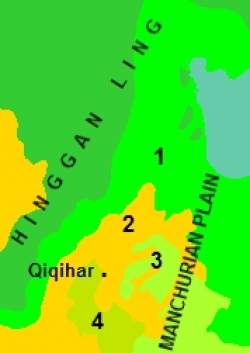Nenjiang River
| Topics: |
The Nenjiang River (also termed the Nen River, Nonni River, Nen Jiang or Nen Chiang) is a major river in northeast China which flows largely south into the the Songhua River, which in turn flows northeast to join the Amur River on the border with Russia and ultimately flows to the Pacific Ocean.
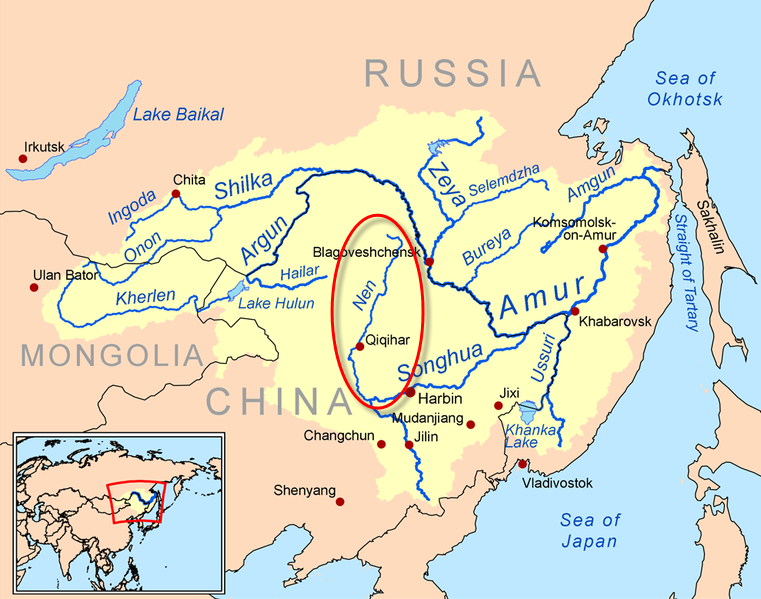 Nenjiang River in context of the larger Amur Basin. Source: Creative Commons-3.0
Nenjiang River in context of the larger Amur Basin. Source: Creative Commons-3.0
The terrestrial basin of the Nenjiang River is chiefly characterised byManchurian mixed forests; Mongolian-Manchurian grassland; Northeast China Plain deciduous forests; and, Nenjiang River grassland. The basin's rich soils have enticed intensive agricultural exploitation, and the ecoregion also suffers from overfishing.
The Nenjiang River Basin has important birdlife, especially a number of rare and endangered cranes. In an opposite sense, this basin is quite depauperate with respect to reptile taxa.
The Nenjiang Basin is floodprone with recent major floods having occurred in 1998 and 2005.
Contents
Basin configuration
The Nenjiang River rises in the Da Xing'an (Da Hinggan or Greater Khingan) range of mountains of northeast China near the border with Russia. These low mountains (average eleveation of approximately 4000 feet or 1200 metres) separate the Manchurian plain to the east from the Manchurian Plateau to the west. The basin is circumscribed by the Large Hinggan to the west and the Little Hinggan to the north.
After rising in the Da Hinggan ranges at the north, the Nenjiang spends most of its course winding in a southerly direction over a broad, level, fertile floodplain. Eventually the Nenjiang joins the mainstem of the Songhua River; for which it is the longest influent element; and which, in turn, is the largest tributary to the massive Amur River.
In the south, higher mountain landforms that define the northern extent of the Korean Peninsula demarcate the broader Songhua tributary plain.
Chief tributaries of the Nenjiang include: Gan River of Inner Mongolia; Namoer River; Nuomin River; Wuyuer River; Yalu River; Chuoer River; Taoer River; and the Huolin River.
Basin vegetation
|
Ecoregions of the Nenjiang River Basin: [1] Manchurian mixed forests; [2] Mongolian-Manchurian grassland; [3] Northeast China Plain decisduous forests; [4] Nenjiang River grassland. Source: WWF |
Typical vegetation in the lowlands of the Nenjiang River Basin consists of a distinctive coniferous swamp forest interspersed among meadows dominated by grasses and sedges.
Forests are dominated by Larch trees (Larix gmelini ssp. olgensis) which typically emerge through a lower tier of Japanese White Birch (Betula platyphylla subsp. mandshurica).
Meadows are generally dominated by grasses such as Chee Reed Grass (Calamagrostis epigeios) and another boreal reedgrass, C. purpurea, that are adapted to thrive in flooded soils. These taxa often grow as dense tussocks that emerge from the flooded areas. Lakes are sometimes filled or lined at their margins by the salt-tolerant reed, Phragmites australis.
The basin contains extensive flooded grassland areas, typified by the landscapes contained within its two largest nature reserves, Zhalong (in Heilongjiang Province) and Momoge (in Jilin Province).
Among the flooded meadows are shallow, reed-choked lakes, rivers and old river courses undergoing ecological succession to grassland.
Lakes may be either fresh or brackish, and salt concentrations are increasing over time in many locales as a result of freshwater diversions for agriculture.
Basin birdlife
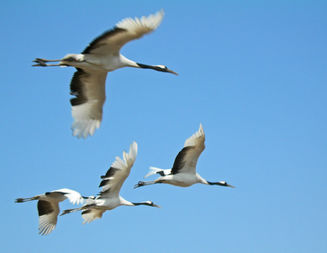 Red-crowned Cranes in flight, northeast China. @ C.Michael Hogan The Nenjiang Basin is a catchment with ideal breeding habitat for a number of rare and endangered cranes including the Critically Endangered Siberian Crane (Grus leucogeranus), the Endangered Red-crowned Crane (Grus japonensis), the Vulnerable White-naped Crane (Grus vipio); the Demoiselle Crane (Grus virgo) is also found in the Nenjiang Basin.
Red-crowned Cranes in flight, northeast China. @ C.Michael Hogan The Nenjiang Basin is a catchment with ideal breeding habitat for a number of rare and endangered cranes including the Critically Endangered Siberian Crane (Grus leucogeranus), the Endangered Red-crowned Crane (Grus japonensis), the Vulnerable White-naped Crane (Grus vipio); the Demoiselle Crane (Grus virgo) is also found in the Nenjiang Basin.
Other notable bird species breeding in the Nenjiang Basin are White Stork (Ciconia ciconia), Black Stork (C. nigra), Oriental White Ibis (Threskiornis aethiopicus melanocephalus), Great Bustard (Otis tarda, VU), Mandarin Duck (Aix galericulata), and Eurasian Spoonbill (Platalea leucorodia). In total, there are a large number of resident and migratory bird species in the Nenjiang Basin.
Basin mammals
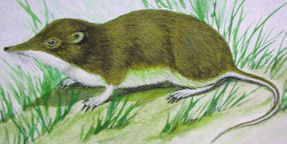 Siberian Large-toothed Shrew. Source: 岩崑/Eol Notable mammals in the Nenjiang Basin include the Dhole (Cuon alpinus, EN), the Corsac Fox (Vulpes corsac), the Siberian Large-toothed Shrew (Sorex daphaenodon), the Manchurian Hare (Lepus mandshuricus) and a variety of other carnivores and herbivores.
Siberian Large-toothed Shrew. Source: 岩崑/Eol Notable mammals in the Nenjiang Basin include the Dhole (Cuon alpinus, EN), the Corsac Fox (Vulpes corsac), the Siberian Large-toothed Shrew (Sorex daphaenodon), the Manchurian Hare (Lepus mandshuricus) and a variety of other carnivores and herbivores.
Water quality
The Nenjiang Basin has experienced ongoing water pollution effluent impacts of heavy metals as well as nitrate and nitrite loading. These nitrogen loadings include effluent from municipal wastewater, as well as agricultural runoff from poorly managed application of fertiliser. Much of the municipal wastewater impact results from communities in the watershed that have inadequate sewage treatment facilities, generating considerable amounts of wastewater that is untreated or partially treated (i.e. less than secondary treatment).
While federal and local agencies in China have nominal discharge standards, in practise these regulations are unevenly and sporadically applied. Furthermore, most of the water quality standards are based on discharge levels, which can be easily circumvented by simply diluting the discharge effluent. Western standards generally also have ambient water concentration standards for each pollutant class, and thus are more stringent controls.
Protected areas in the basin
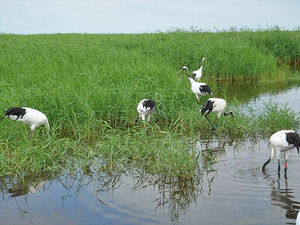 Red-crowned Cranes in marshland, Zhalong Preserve. CC-3.0 Two large nature reserves protect wetland habitat in the Nenjiang Basin - Zhalong (in Heilongjiang Province) and Momoge (in Jilin Province).
Red-crowned Cranes in marshland, Zhalong Preserve. CC-3.0 Two large nature reserves protect wetland habitat in the Nenjiang Basin - Zhalong (in Heilongjiang Province) and Momoge (in Jilin Province).
The Zhalong Nature Reserve (2100 square kilometres), located in the lower drainage basin of the Wuyur (Ulun) River east of the city of Qiqihar, is a vast complex of permanent and seasonal freshwater marshes with countless shallow lakes and ponds and extensive reed beds (Phragmites spp.). Extensive flooding occurs here during the spring and summer rainy season. The Momoge National Nature Reserve consists of 1440 square kilometres, four fifths of which are wetland visited by myriads of cranes and other birds.
The Zhalong Nature Reserve serves as a wetland breeding area for bird species such as the rare Red-crowned Crane (Grus japonensis) and Chinese Merganser (Mergus squamatus). In addition to flooded grasslands, the reserve includes a network of freshwater reed marshes (measuring approximately 400 square kilometres) that line or fill numerous small lakes and ponds. Natural lakes are mostly permanent freshwater, although some are seasonal or saline. During the April-June breeding season, productivity is high, with plentiful fish, frogs, mollusks and aquatic insects, making this an ideal breeding area for waterfowl.
References
- Asian Development Bank. 2005. People’s Republic of China: Songhua River Basin Water Quality and Pollution Control Management: Strategic Planning Report.
- Chinese Vegetation Map Compilation Committee (CVMCC). 1979. Vegetation map of China. Map (1:10,000,000). Science Press, Beijing. ISBN: 7030089561
- J. MacKinnon and K. Phillipps. 2000. A Field Guide to the Birds of China. Oxford University Press, New York. ISBN: 0198549407
- C.D. Meine and G.W. Archibald. eds. 1996. The cranes: Status survey and conservation action plan. IUCN, Gland, Switzerland, and Cambridge, U.K. 294pp. Northern Prairie Wildlife Research Center Home Page. (Version 02MAR98)
- World Wildlife Fund. 2008. Nenjiang River grassland. Topic eds. M. McGinley & C.M. Hogan. Encyclopedia of Earth. National Council for Science and the Environment. Washington DC

